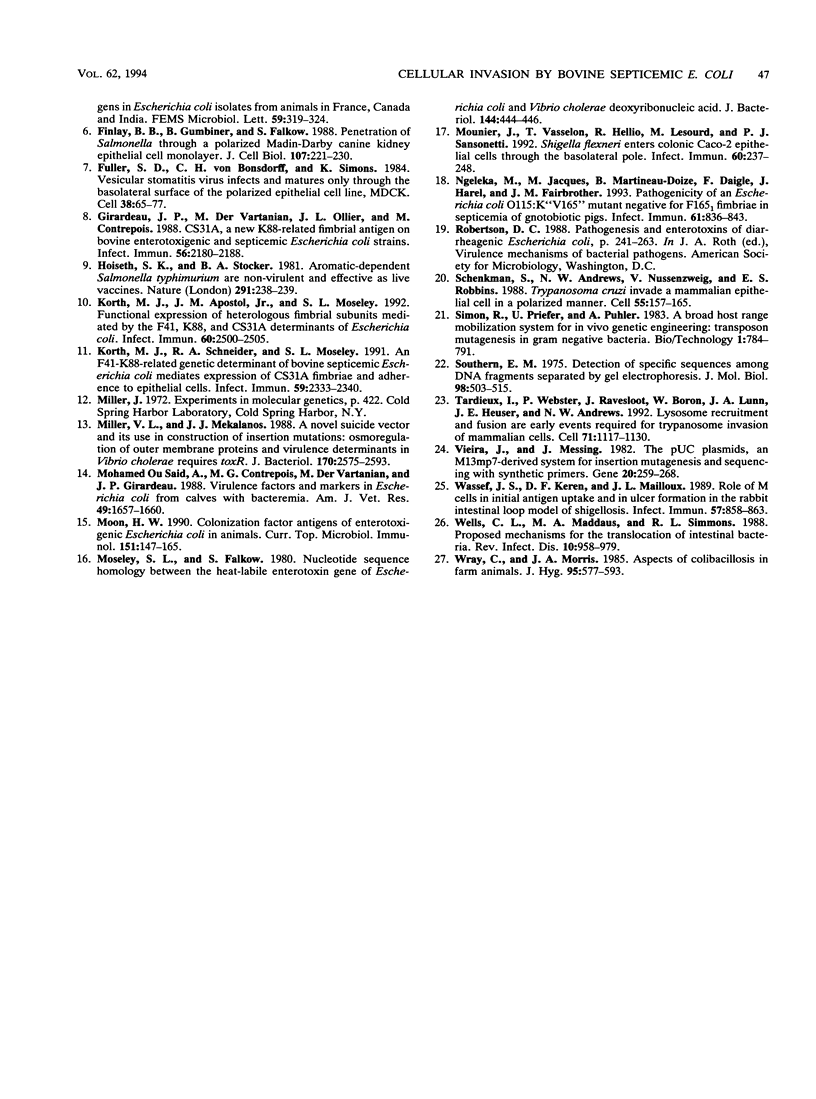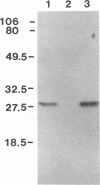Abstract
Little is known regarding the pathogenesis of Escherichia coli-induced septicemic colibacillosis of calves. To understand the mechanism by which these strains penetrate the intestinal epithelium and gain access to the bloodstream, we examined the potential of bovine septicemic E. coli to invade cultured epithelial cells. By using a gentamicin survival assay, we demonstrated bacterial invasion of Madin-Darby canine kidney (MDCK) cells. Transcytosis of polarized MDCK cell monolayers was also observed, but only when bacteria were added to the basolateral surface. Electron microscopy confirmed the presence of intracellular organisms which appeared to be within membrane-bound vacuoles. The bovine septicemic isolate used in this study expressed the fimbrial adhesion CS31A. To examine the role of CS31A-mediated adherence in invasion and transcytosis of MDCK cell monolayers, a CS31A-deficient mutant was constructed by suicide vector-mediated insertional mutagenesis. Although nonadherent, the mutant showed a level of invasion similar to that of the wild-type parent. E. coli DH5 alpha carrying the cloned CS31A determinant was noninvasive. These findings suggest that expression of CS31A is neither required nor sufficient to mediate invasion.
Full text
PDF






Images in this article
Selected References
These references are in PubMed. This may not be the complete list of references from this article.
- Casey T. A., Moseley S. L., Moon H. W. Characterization of bovine septicemic, bovine diarrheal, and human enteroinvasive Escherichia coli that hybridize with K88 and F41 accessory gene probes but do not express these adhesins. Microb Pathog. 1990 Jun;8(6):383–392. doi: 10.1016/0882-4010(90)90025-l. [DOI] [PubMed] [Google Scholar]
- Contrepois M., Dubourguier H. C., Parodi A. L., Girardeau J. P., Ollier J. L. Septicaemic Escherichia coli and experimental infection of calves. Vet Microbiol. 1986 Jul;12(2):109–118. doi: 10.1016/0378-1135(86)90073-8. [DOI] [PubMed] [Google Scholar]
- Contrepois M., Fairbrother J. M., Kaura Y. K., Girardeau J. P. Prevalence of CS31A and F165 surface antigens in Escherichia coli isolates from animals in France, Canada and India. FEMS Microbiol Lett. 1989 Jun;50(3):319–323. doi: 10.1016/0378-1097(89)90439-4. [DOI] [PubMed] [Google Scholar]
- Finlay B. B., Gumbiner B., Falkow S. Penetration of Salmonella through a polarized Madin-Darby canine kidney epithelial cell monolayer. J Cell Biol. 1988 Jul;107(1):221–230. doi: 10.1083/jcb.107.1.221. [DOI] [PMC free article] [PubMed] [Google Scholar]
- Fuller S., von Bonsdorff C. H., Simons K. Vesicular stomatitis virus infects and matures only through the basolateral surface of the polarized epithelial cell line, MDCK. Cell. 1984 Aug;38(1):65–77. doi: 10.1016/0092-8674(84)90527-0. [DOI] [PubMed] [Google Scholar]
- Girardeau J. P., Der Vartanian M., Ollier J. L., Contrepois M. CS31A, a new K88-related fimbrial antigen on bovine enterotoxigenic and septicemic Escherichia coli strains. Infect Immun. 1988 Aug;56(8):2180–2188. doi: 10.1128/iai.56.8.2180-2188.1988. [DOI] [PMC free article] [PubMed] [Google Scholar]
- Haggard D. L. Bovine enteric colibacillosis. Vet Clin North Am Food Anim Pract. 1985 Nov;1(3):495–508. doi: 10.1016/S0749-0720(15)31298-6. [DOI] [PMC free article] [PubMed] [Google Scholar]
- Hoiseth S. K., Stocker B. A. Aromatic-dependent Salmonella typhimurium are non-virulent and effective as live vaccines. Nature. 1981 May 21;291(5812):238–239. doi: 10.1038/291238a0. [DOI] [PubMed] [Google Scholar]
- Korth M. J., Apostol J. M., Jr, Moseley S. L. Functional expression of heterologous fimbrial subunits mediated by the F41, K88, and CS31A determinants of Escherichia coli. Infect Immun. 1992 Jun;60(6):2500–2505. doi: 10.1128/iai.60.6.2500-2505.1992. [DOI] [PMC free article] [PubMed] [Google Scholar]
- Korth M. J., Schneider R. A., Moseley S. L. An F41-K88-related genetic determinant of bovine septicemic Escherichia coli mediates expression of CS31A fimbriae and adherence to epithelial cells. Infect Immun. 1991 Jul;59(7):2333–2340. doi: 10.1128/iai.59.7.2333-2340.1991. [DOI] [PMC free article] [PubMed] [Google Scholar]
- Miller V. L., Mekalanos J. J. A novel suicide vector and its use in construction of insertion mutations: osmoregulation of outer membrane proteins and virulence determinants in Vibrio cholerae requires toxR. J Bacteriol. 1988 Jun;170(6):2575–2583. doi: 10.1128/jb.170.6.2575-2583.1988. [DOI] [PMC free article] [PubMed] [Google Scholar]
- Mohamed Ou Said A., Contrepois M. G., Der Vartanian M., Girardeau J. P. Virulence factors and markers in Escherichia coli from calves with bacteremia. Am J Vet Res. 1988 Oct;49(10):1657–1660. [PubMed] [Google Scholar]
- Moon H. W. Colonization factor antigens of enterotoxigenic Escherichia coli in animals. Curr Top Microbiol Immunol. 1990;151:147–165. doi: 10.1007/978-3-642-74703-8_8. [DOI] [PubMed] [Google Scholar]
- Moseley S. L., Falkow S. Nucleotide sequence homology between the heat-labile enterotoxin gene of Escherichia coli and Vibrio cholerae deoxyribonucleic acid. J Bacteriol. 1980 Oct;144(1):444–446. doi: 10.1128/jb.144.1.444-446.1980. [DOI] [PMC free article] [PubMed] [Google Scholar]
- Mounier J., Vasselon T., Hellio R., Lesourd M., Sansonetti P. J. Shigella flexneri enters human colonic Caco-2 epithelial cells through the basolateral pole. Infect Immun. 1992 Jan;60(1):237–248. doi: 10.1128/iai.60.1.237-248.1992. [DOI] [PMC free article] [PubMed] [Google Scholar]
- Ngeleka M., Jacques M., Martineau-Doizé B., Daigle F., Harel J., Fairbrother J. M. Pathogenicity of an Escherichia coli O115:K"V165" mutant negative for F165(1) fimbriae in septicemia of gnotobiotic pigs. Infect Immun. 1993 Mar;61(3):836–843. doi: 10.1128/iai.61.3.836-843.1993. [DOI] [PMC free article] [PubMed] [Google Scholar]
- Schenkman S., Andrews N. W., Nussenzweig V., Robbins E. S. Trypanosoma cruzi invade a mammalian epithelial cell in a polarized manner. Cell. 1988 Oct 7;55(1):157–165. doi: 10.1016/0092-8674(88)90018-9. [DOI] [PubMed] [Google Scholar]
- Southern E. M. Detection of specific sequences among DNA fragments separated by gel electrophoresis. J Mol Biol. 1975 Nov 5;98(3):503–517. doi: 10.1016/s0022-2836(75)80083-0. [DOI] [PubMed] [Google Scholar]
- Tardieux I., Webster P., Ravesloot J., Boron W., Lunn J. A., Heuser J. E., Andrews N. W. Lysosome recruitment and fusion are early events required for trypanosome invasion of mammalian cells. Cell. 1992 Dec 24;71(7):1117–1130. doi: 10.1016/s0092-8674(05)80061-3. [DOI] [PubMed] [Google Scholar]
- Vieira J., Messing J. The pUC plasmids, an M13mp7-derived system for insertion mutagenesis and sequencing with synthetic universal primers. Gene. 1982 Oct;19(3):259–268. doi: 10.1016/0378-1119(82)90015-4. [DOI] [PubMed] [Google Scholar]
- Wassef J. S., Keren D. F., Mailloux J. L. Role of M cells in initial antigen uptake and in ulcer formation in the rabbit intestinal loop model of shigellosis. Infect Immun. 1989 Mar;57(3):858–863. doi: 10.1128/iai.57.3.858-863.1989. [DOI] [PMC free article] [PubMed] [Google Scholar]
- Wells C. L., Maddaus M. A., Simmons R. L. Proposed mechanisms for the translocation of intestinal bacteria. Rev Infect Dis. 1988 Sep-Oct;10(5):958–979. doi: 10.1093/clinids/10.5.958. [DOI] [PubMed] [Google Scholar]
- Wray C., Morris J. A. Aspects of colibacillosis in farm animals. J Hyg (Lond) 1985 Dec;95(3):577–593. doi: 10.1017/s002217240006068x. [DOI] [PMC free article] [PubMed] [Google Scholar]






